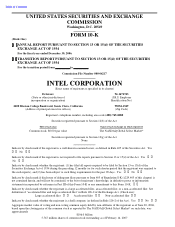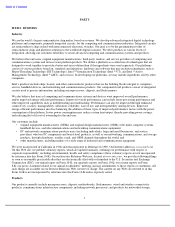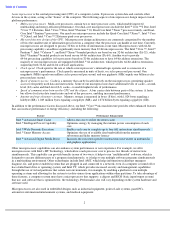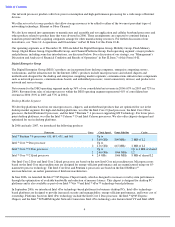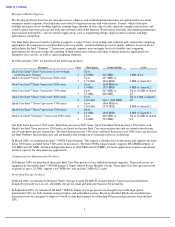Intel 2006 Annual Report Download - page 12
Download and view the complete annual report
Please find page 12 of the 2006 Intel annual report below. You can navigate through the pages in the report by either clicking on the pages listed below, or by using the keyword search tool below to find specific information within the annual report.
Table of Contents
Mobility Group
The Mobility Group’s products currently include microprocessors and related chipsets designed for the notebook market
segment and wireless connectivity products. In 2006, the Mobility Group’s products also included cellular baseband
processors and application processors. In the fourth quarter of 2006, we sold certain assets of our communications and
application processor business line to Marvell Technology Group, Ltd. The divestiture of these assets included the cellular
baseband processor and application processor product lines. These product lines are based on Intel XScale technology and are
designed for wireless handheld devices such as handsets, PDAs, and mobile phones. Intel and Marvell entered into an
agreement whereby we are providing certain manufacturing and transition services to Marvell for a limited time. For further
discussion of our divestitures, see “Note 14: Acquisitions and Divestitures” in Part II, Item 8 of this Form 10-K.
Net revenue for the Mobility Group operating segment made up 35% of our consolidated net revenue in 2006 (29% in 2005
and 20% in 2004). Revenue from sales of microprocessors within the Mobility Group represented 26% of consolidated net
revenue in 2006 (22% in 2005 and 17% in 2004).
We offer mobile computing microprocessors at a variety of price/performance points, allowing our customers to meet the
demands of a wide range of notebook PC designs. These notebook designs include transportable notebooks, which provide
desktop-like features such as higher performance processors, full-size keyboards, larger screens, and multiple drives;
thin-and-light models, including those optimized for wireless networking; and ultra-portable designs. Within the ultra-portable
design category, we provide specialized low-voltage processors targeted for the mini-notebook market segment, and ultra-low-
voltage processors targeted for the sub-notebook
and tablet market segments of notebook PCs weighing less than 3 pounds and
measuring 1 inch or less in height. For high-end mobility platforms, we offer the Intel Core 2 Duo, Intel Core Duo, Intel
®
Core
TM
Solo, and Intel
®
Pentium
®
M processors. For lower price-point mobile platforms, we offer the Intel
®
Celeron
®
M
and Mobile Intel
®
Celeron
®
processors.
In 2006, a substantial majority of the revenue in the Mobility Group operating segment was from sales of products that make
up Intel
®
Centrino
®
and Intel
®
Centrino
®
Duo mobile technology. Intel Centrino mobile technology consists of either the
Intel Core Solo and the mobile Intel
®
945 Express Chipset, or the Intel Pentium M processor and the mobile Intel
®
915
Express Chipset; and an Intel wireless network connection. Intel Centrino mobile technology is designed to provide high
performance, improved battery life, small form factor, and wireless connectivity. The Intel Centrino Duo mobile technology
platform expands on the capabilities of Intel Centrino mobile technology with improved multitasking performance, power-
saving features to further improve battery life, and a more flexible wireless network connection. Intel Centrino Duo mobile
technology consists of either the Intel Core 2 Duo or the Intel Core Duo processor together with the mobile Intel 945 Express
Chipset and the Intel
®
PRO/Wireless 3945ABG Network Connection. Intel Centrino Duo and Intel Centrino mobile
technology both enable users to take advantage of wireless capabilities at work and at home, with the installation of the
appropriate base-station equipment, as well as at thousands of wireless “hotspots” installed around the world.
In July 2006, we introduced the first mobile processors based on the new Intel Core microarchitecture. Intel Core 2 Duo
mobile processors are designed for energy-efficient, 32- and 64-bit mobile computing. Based on our 65-nanometer process
technology, these processors run at speeds of up to 2.33 GHz, support a 667-MHz
bus, include up to 4 MB of shared L2 cache,
and operate at 1.3 volts.
In October 2006, we introduced the Intel
®
WiMAX Connection 2250, our first dual-mode WiMAX chip, which supports both
mobile and fixed networks and is designed for building cost-effective WiMAX modems.
In January 2007, we introduced the Intel
®
Next-Gen Wireless-N network connection. This product is based on the draft
802.11n WiFi specification and is designed to provide faster performance over a longer range than existing Intel products.
Flash Memory Group
The Flash Memory Group provides advanced flash memory products for a variety of digital devices. Net revenue for the Flash
Memory Group operating segment made up 6% of our consolidated net revenue in 2006 (6% in 2005 and 7% in 2004). In
2006, most of the revenue in the Flash Memory Group was derived from our NOR flash memory products.
6



